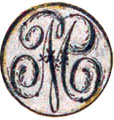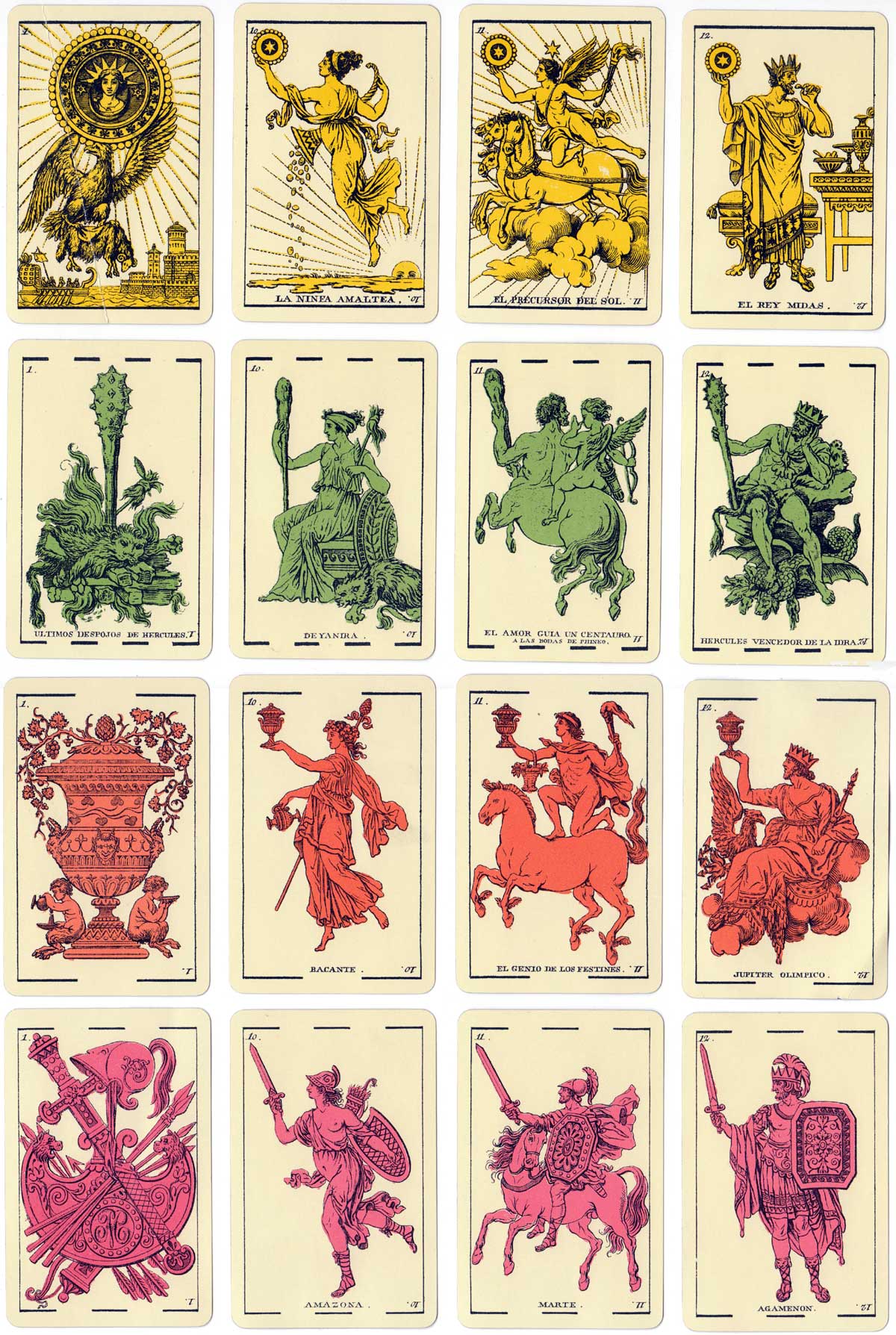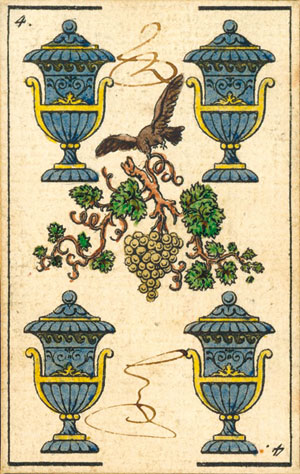Baraja Mitológica
“Baraja Mitológica” was first published in Madrid in c.1815 by Josef Monjardín from engravings by José Martínez de Castro.

The “Baraja Mitológica” was first published in Madrid in c.1815 by Josef Monjardín from engravings by José Martínez de Castro, whose monogram appears on the ace of swords. The original drawings were probably by José de Rojas. In those days engravers might arrange for a local printer to produce their work and then sell the finished products themselves; alternatively they might sell the engravings to an established publisher. Consequently many editions appeared either anonymously, self-published or by different publishers. The printer’s details may or may not have appeared on the wrapper of a particular edition.
As can be seen in the images below, José Martínez de Castro’s engavings exhibit superb draughtmanship, clean and precise lines without any unnecessary ornamentation or fussiness. José de Rojas would have availed himself of the countless dictionaries of mythology and emblematic material available in 19th century Spain.
Above: cards from a hand-coloured edition of “Baraja Mitológica” by an unknown publisher from copper plate engravings by José Martínez de Castro, Madrid, 1817. The court cards depict classical heroes and deities. Images courtesy Alberto Pérez González.
A facsimile edition of the cards was published by Heraclio Fournier in 1989, based on an original copy published in Madrid in 1815 by Josef Monjardín, now in the Fournier Playing Card Museum, Álava. Each suit is coloured in monochrome, and there are differences of detail in some numeral cards from the edition shown above, suggesting that the plates had been re-touched or repaired. See the information cards► See the Box►

Above: cards from facsimile edition published by Heraclio Fournier in 1989, based on an original copy published in 1815 by Josef Monjardín.
Right: the four of cups with the signatures of the tax accountant and administrator. (click to zoom) →
REFERENCES and CREDITS
Denning, Trevor: Catalogue of Trevor Denning’s Collection of Spanish Playing Cards, Birmingham, privately published.
Pérez González, Alberto & Ferro Torrelles, Víctor: El Archivo Desconocido de la Baraja Española, in LA SOTA no.21, Asescoin, Madrid, October 1999
Thanks to Alberto Pérez and Samten de Wet for additional research and to Rex Pitts for scans of the facsimile edition by Heraclio Fournier.

By Simon Wintle
Member since February 01, 1996
I am the founder of The World of Playing Cards (est. 1996), a website dedicated to the history, artistry and cultural significance of playing cards and tarot. Over the years I have researched various areas of the subject, acquired and traded collections and contributed as a committee member of the IPCS and graphics editor of The Playing-Card journal. Having lived in Chile, England, Wales, and now Spain, these experiences have shaped my work and passion for playing cards. Amongst my achievements is producing a limited-edition replica of a 17th-century English pack using woodblocks and stencils—a labour of love. Today, the World of Playing Cards is a global collaborative project, with my son Adam serving as the technical driving force behind its development. His innovative efforts have helped shape the site into the thriving hub it is today. You are warmly invited to become a contributor and share your enthusiasm.
Related Articles

Zürcher Festspiel 1903
Swiss-suited pack designed by Robert Hardmeyer featuring figures from art and politics.

Tarot de las Coscojas
Historical playing card design, tarot symbolism and an almost psychedelic medieval surrealism.

Tarot de Valverde de la Vera
A series of 24 surrealist engravings by Mexican artist Claudio Favier in which archetypal Tarot alle...

Songs with Flute accompaniment
Eighteenth century English engraved cards with music for voice and flute.

The Game of the Gods
Figures and symbols from Norse mythology, designed by Barbro Gustafsson and Inga Lundström.

Never Mind the Belote
Limited edition Belote pack with designs by a collective of 24 street artists.

Playing card designs by Franz Exler
Reconstruction of playing cards from the original 1903 designs.

MITSCHKAtzen
Clever cat designs by the Austrian artist and illustrator Willi Mitschka.

22 Pittori in 22 Arcani
Collaborative Tarot with contributions from 22 different Italian artists including Menegazzi and Tav...

Baraja de Juan Martín Zamorano
Deck inspired by El Pendón de los Zamorano, a military pennant dating from 1501, published by Priego...

Whist by Ditha Moser
Ditha Moser created this minimalist Whist deck in 1905, in the style of the Vienna Secession art mov...

Beowulf
Jackson Robinson's Beowulf playing card deck inspired by the Old English pagan poem.

Keith Haring playing cards
Energetic graffiti images by the American artist Keith Haring.

Heráldica Castanyer No. 16
Strange variant of international pattern cards for poker or bridge.

Fantasy Spanish-suited deck
Fantasy Spanish-suited deck by Bertschinger y Codina, Barcelona.

Carte di Natale
Designed by Pier Canosa as a Christmas pack for the Cortina Art Gallery in Milan.
Most Popular
Our top articles from the past 28 days







